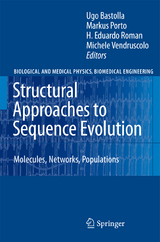Structural Approaches to Sequence Evolution
Springer Berlin (Verlag)
978-3-540-35305-8 (ISBN)
Structural requirements constrain the evolution of biological entities at all levels, from macromolecules to their networks, right up to populations of biological organisms. Classical models of molecular evolution, however, are focused at the level of the symbols - the biological sequence - rather than that of their resulting structure. Now recent advances in understanding the thermodynamics of macromolecules, the topological properties of gene networks, the organization and mutation capabilities of genomes, and the structure of populations make it possible to incorporate these key elements into a broader and deeply interdisciplinary view of molecular evolution. This book gives an account of such a new approach, through clear tutorial contributions by leading scientists specializing in the different fields involved.
Ugo Bastolla is researcher in the laboratory of bioinformatics of the Centro de Astrobiologia in Madrid (Spain), on leave to the Centro de Biologia Molecular of the Spanish CSIC. Since his degree in physics with Luca Peliti he has always been interested in biological topics, above all evolution. He got is PhD in Rome with Giorgio Parisi working on disordered dynamical systems inspired to biology and was postdoc in Julich (Germany) with Peter Grassberger, studying statistical mechanical models of polymers, in Berlin (Germany) with E.W. Knapp studying simple protein models, in Golm (Germany) with Michael Laessig, studying ecological models, and finally in Madrid (Spain) in the bioinformatics group of Alfonso Valencia. His main research interest consists in combining simple models of protein thermodynamics and evolution. Markus Porto is professor of Theoretical Solid State Physics at the Institut fur Festkorperphysik at the Technische Universitat Darmstadt (Germany). He received his PhD at the Universitat Giessen (Germany). His research interests cover many aspects of solid state and statistical physics, including transport and relaxation in disordered systems and biophysics, as well as applying methods of statistical physics to model molecular evolution. H. Eduardo Roman is Research Fellow at the Department of Physics of the University of Milan-Bicocca. He earned his Ph.D at the International School for Advanced Studies, Trieste (Italy), and has been Privat Dozent at the Universities of Hamburg and Giessen (Germany). His research interests cover many aspects of Statistical Physics, from fractals to stochastic phenomena, biophysics, proteins and evolution, and ab-initio electronic calculations in molecules. Michele Vendruscolo is a Royal Society University Research Fellow at the Department of Chemistry, University of Cambridge. He received his PhD in Condensed Matter Physics in 1996 at the International School for Advanced Studies, Trieste (Italy). His research is mainly focussed on understanding the biophysical principles regulating the behaviour and the evolution of proteins.
Molecules: Proteins and RNA.- Modeling Conformational Flexibility and Evolution of Structure: RNA as an Example.- Gene3D and Understanding Proteome Evolution.- The Evolution of the Globins: We Thought We Understood It.- The Structurally Constrained Neutral Model of Protein Evolution.- Towards Unifying Protein Evolution Theory.- Molecules: Genomes.- A Twenty-First Century View of Evolution: Genome System Architecture, Repetitive DNA, and Natural Genetic Engineering.- Genomic Changes in Bacteria: From Free-Living to Endosymbiotic Life.- Phylogenetic Analysis.- Molecular Phylogenetics: Mathematical Framework and Unsolved Problems.- Phylogenetics and Computational Biology of Multigene Families.- SeqinR 1.0-2: A Contributed Package to the R Project for Statistical Computing Devoted to Biological Sequences Retrieval and Analysis.- Networks.- Evolutionary Genomics of Gene Expression.- From Biophysics to Evolutionary Genetics: Statistical Aspects of Gene Regulation.- Populations.- Drift and Selection in Evolving Interacting Systems.- Adaptation in Simple and Complex Fitness Landscapes.- Genetic Variability in RNA Viruses: Consequences in Epidemiology and in the Development of New Stratgies for the Extinction of Infectivity.
| Erscheint lt. Verlag | 25.6.2007 |
|---|---|
| Reihe/Serie | Biological and Medical Physics, Biomedical Engineering |
| Zusatzinfo | XIX, 367 p. |
| Verlagsort | Berlin |
| Sprache | englisch |
| Maße | 155 x 235 mm |
| Themenwelt | Informatik ► Weitere Themen ► Bioinformatik |
| Naturwissenschaften ► Biologie ► Biochemie | |
| Naturwissenschaften ► Physik / Astronomie ► Angewandte Physik | |
| Schlagworte | Bioinformatics • Biology • Biophysics • Computational Biology • DNA • Evolution • gene expression • genes • Genetic Engineering • Genetics • Genome • genomics • Molecular Evolution • Population • Population Genetics • Protein • systems biology • thermodynamics • Thermodynamics of macromolecules |
| ISBN-10 | 3-540-35305-4 / 3540353054 |
| ISBN-13 | 978-3-540-35305-8 / 9783540353058 |
| Zustand | Neuware |
| Haben Sie eine Frage zum Produkt? |
aus dem Bereich




